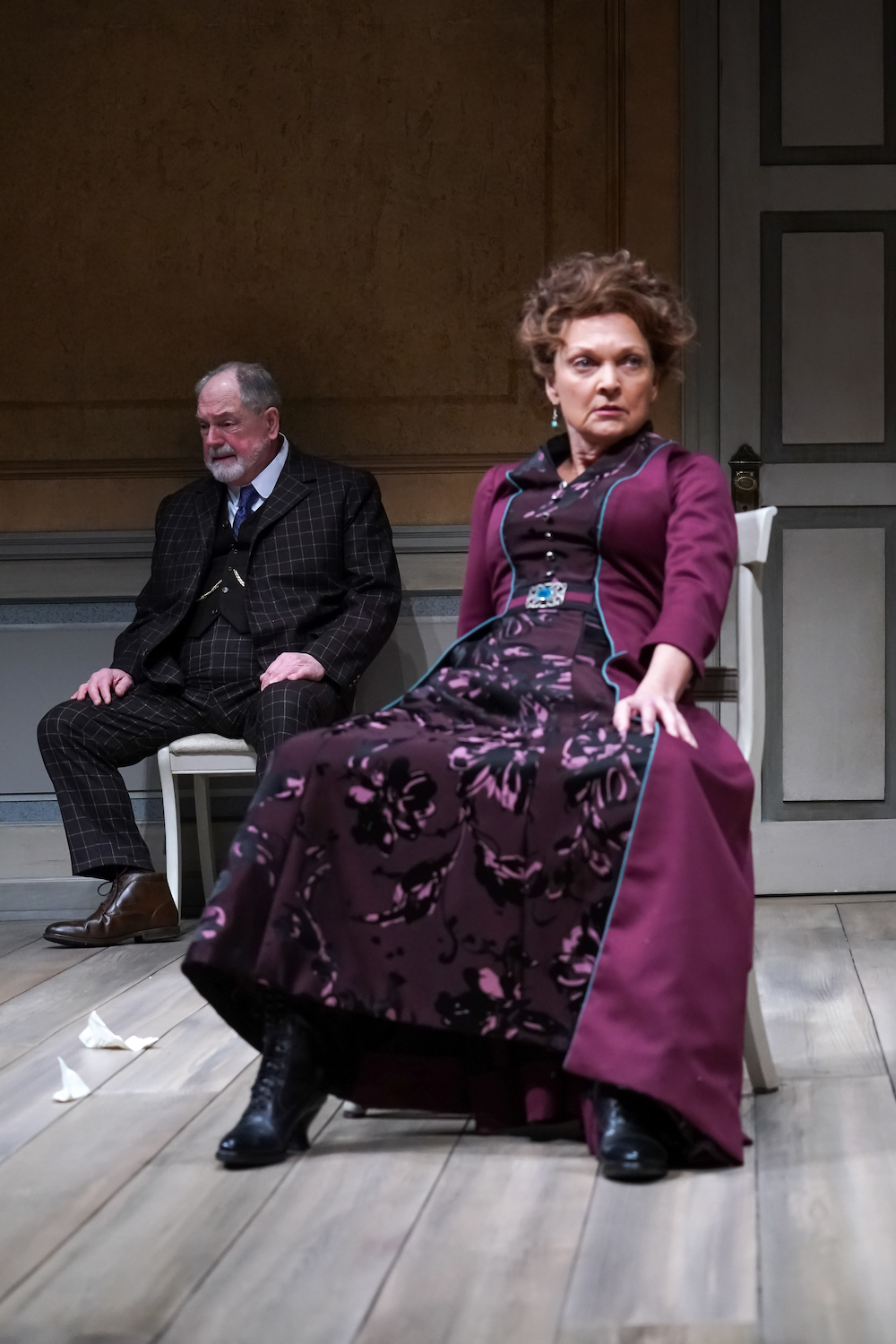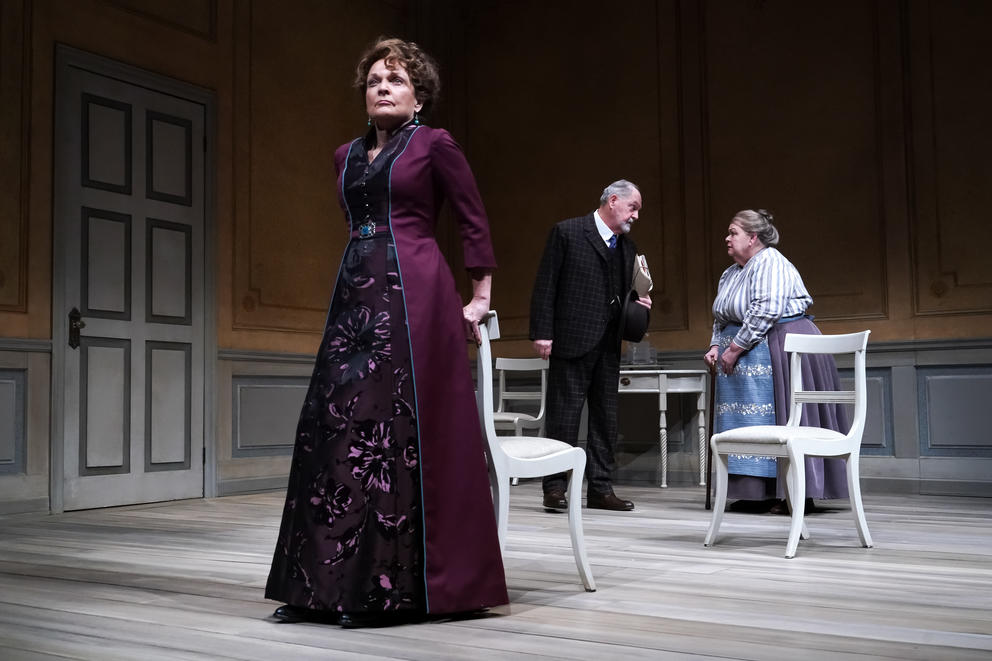She’s happy to tell you. First of all, “Theater is home to me,” says the petite, animated University of Washington drama grad, who has carved out a successful career on film and TV (including recurring roles on NCIS: Los Angeles and Parks and Recreation). Six years ago, she moved back to the Tacoma area, and in Seattle has won justified acclaim for her stage turns as the battling spouse Martha in Who’s Afraid of Virginia Woolf? and an overwhelmed social worker in Luna Gale.
Reason No. 2: Nora is just the kind of multifaceted, imposing role a skilled and mature female performer like Reed can really dig into and make her own. She does so handily in the current Seattle Repertory Theatre local premiere production of A Doll’s House, Part 2, which runs through April 28.
Over coffee at a Queen Anne coffee house near the Rep, Reed described Nora “as a woman who breaks out of her own proscribed world, and has the ability to both save herself and other women.”
In Braden Abraham’s Rep staging, Reed captures Nora’s gutsiness and exasperation, her determination and pangs of regret, as she returns to her former home 15 years after slamming the door on her husband, two young children and a suffocating Victorian-era marriage.
That was the ending of Ibsen’s A Doll's House. Now she’s back in the same provincial Norwegian town, on a mission: to get her husband, Torvald, to finalize their divorce. Nora needs the closure, not emotionally but in her new life as a successful author who wants to get on with her work and avoid a career-crushing scandal. We are reminded that in Nora’s day, a married woman couldn’t sign a book deal or any other kind of contract without her spouse’s consent.
“I read about this new play and had to see it,” Reed recalled. She took in the Broadway version, with a Tony-winning portrayal of Nora by Laurie Metcalf (Roseanne, Lady Bird), who as Nora exhibited a quirky edginess, at times outright butch physicality in the way she sat, strutted, gasped and grimaced through a fraught reunion.
Metcalf “moved forward with a very dogmatic, funny, great approach,” Reed said. “But it was important for me to embrace every solid inch of Nora’s emancipation in another way.” She infuses the character with something different: a seemingly calm dignity, almost a nobility, fraying at the seams with frustration and speared with withering wit.
Fully inhabiting Nora’s aggressive stance as the author of her own destiny took some doing for Reed, who has two grown children with her husband, filmmaker Sandy Smolan. “Nora finds out it’s not enough just to kick shame to the curb. The hole in one’s soul must be filled," she said. "And it’s about coming to terms with being yourself with no apology.”
“Something inside of me was stonewalled a little about that,” she revealed. “I was being a little too careful in rehearsal, softening her a bit. But then [the director] Braden asked me, ‘Why are you tiptoeing around this?’ He was right, and facing up to it was good for Nora and good for me.”

When Ibsen’s original Doll’s House premiered in Copenhagen, Denmark, in 1879, Nora’s decision to leave her bourgeois nuclear family life was indeed viewed as shameful — particularly her willingness to part from her children. She would have faced a dicey future in Europe (or America), in an era when a woman was expected to stay fixed in the domestic sphere, as a caregiver and attractive “doll.” The idea of striking out on one’s own, without male financing or protection, was practically sinful.
Though cheered on by George Bernard Shaw and others, the play was damned by some critics, including Norwegian journalist Erik Vullum, who wrote, “There is something indescribably unnatural in this, and therefore, in the final instance, artificial. Even if one can accept that there possibly may exist a woman who has done such a thing, one still feels dissatisfied to the utmost degree when it appears to be something that perhaps also has the sympathy of the author.”
The contemporary American dramatist Hnath cleverly imagines that Nora’s autonomy doesn’t lead to a life of penury and vilification. Instead she forges a successful career as a crusading feminist novelist, has nonbinding romances with numerous men and reaches financial independence.
“Nora is saying in this play, staying with Torvald would have been cruel to me,” emphasized Reed. “She’s saying, if I stayed I would have never had a life outside of motherhood, or be able to speak up on behalf of myself or other women.”
However, she feels that Hnath doesn’t present Nora as “some kind of superwoman.” The play is a debate play in the spirit of G.B. Shaw, a series of one-on-one conversations between Nora and three of the people left behind: her maid Annie Marie (Laura Kenny), a loyal servant who (with few other options herself) would stay to raise Nora’s children; the wounded, embittered Torvald (Michael Winters); and Nora’s smilingly scornful adult daughter, Emmy (Khanh Doan).
“The writer gives equal voice to all four characters, with arguments that are valid for each of them,” said Reed. “During the course of the play they’re all battling each other. But by the end, when Torvald sits down and treats Nora respectfully, and they try to work things out, you see that these aren’t just two people who hate each other. In another world, another time, they could have been good friends.”
Along with her director and fellow castmates (praised by Reed as “all Broadway caliber”), she is grateful to costume designer Deb Trout for the eye-catching, floor-length gown in deep purple satin and brocade that Nora wears. While stylish for the era, it too is liberated, less constricting than the usual late-19th century garb for prosperous women. “Deb is a genius,” stressed Reed. “I asked for pockets. And by giving me that and pulling away some petticoats and some fabric she had around the neck, Deb put a slightly modern twist on a period dress. I really feel like I’m straddling two eras when I’m in that dress.”
Get the latest in local arts and culture
This weekly newsletter brings arts news and cultural events straight to your inbox.



